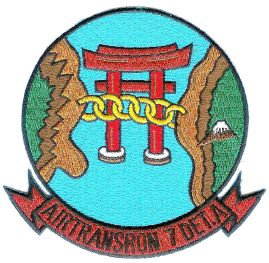In 1957 the parent squadron VR-7, operating the C-121G Super Connies was relocated to NAS Moffett Field CA. Shortly thereafter, four C-121C's from Air Force units at Charleston S.C. were then allocated to the detachment thereby extending their range and payload. A cadre of experienced C-121 personnel was obtained through volunteers from VR-7 and sent to Tachikawa to operate this new equipment, with CDR. K.L. "Whitey" Jones relieving CDR. A.C. Anselmo as Officer-in-Charge. The cadre of personnel included six Flight Engineer Instructors. CDR Jones was later succeeded by CDR Gerdes. The schedule of flights would remain those previously flown by the R5D aircraft.
With the advent of the C-121G Super Connie aircraft, and the increased role by the U.S. in Vietnam and S.E. Asia, the requirement for Medical Air Evacuation became readily apparent. VR-7A, with it's complement of Constellations easily convertible to "air ambulance" configuration was a natural to augment this medical airlift. This required flights through Okinawa, Taipei and Taiwan to Clark AFB in the Philippines alongside the Air Force's 6485th Air Transport Squadron flying litter equipped C-54's. When the C-141 aircraft became available, VR-7A's role ceased.
Unlike most Navy MATS squadrons, VR-7A's personnel not only flew these missions with permanently assigned crews, they also maintained their own aircraft, performing whatever maintenance was necessary. This meant the personnel might work on the aircraft prior to missions, then flying the mission also. This meant many a night was spent returning the aircraft to flying status, followed by a day of flying it. With the age of the C-121G slowly reaching retirement, this became a normal mode of operation.
Although records of this squadrons activities are sorely lacking, from first hand accounts of personnel deployed with this unit, it becomes apparent that the personnel were dedicated, efficient, professional and capable. With little fanfare, the detachment was decommissioned sometime in the late 1960's.

